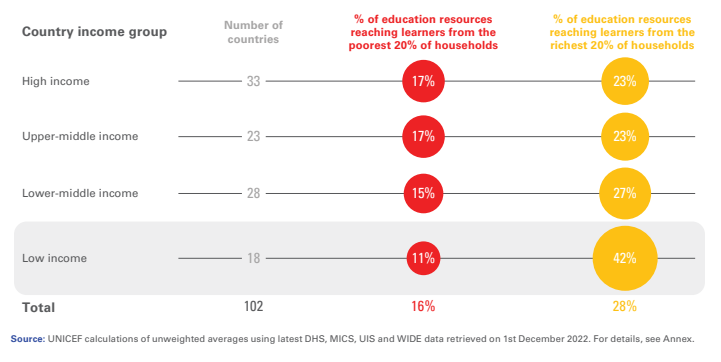A report released by United Nations International Children’s Emergency Fund [UNICEF] on January 16 asserted that the financial aid to education has been inequitable in countries across the world and children from the poorest households benefit the least from public education funding.
The report titled ‘Transforming Education with Equitable Financing’, claimed that on an average, the poorest learners benefit from only 16 per cent of public funding for education, compared to the richest, who benefit from 28 per cent. It further drops to 11 per cent and 42 per cent for low income countries respectively.
“We are failing children. Too many education systems around the world are investing the least in those children who need it the most,” Catherine Russell, the UNICEF Executive Director was quoted in the press statement.

Average distribution of public education funding per learners’ wealth background, 2022 update.
“Investing in the education of the poorest children is the most cost-effective way to ensure the future for children, communities and countries. True progress can only come when we invest in every child, everywhere,” she added.
Also Read: 12yo Chimki was married off last year. She is one of the 226 million child brides in India
According to the report, children living in poverty are less likely to have access to school and drop out sooner. It added that such children are also more likely to be residing in remote and rural areas — underserved and with poor digital access.
It emphasised that a key step to addressing the learning crisis is for governments to provide equitable financing and prioritise public education resources, deeply focusing on foundational learning.

Shares of learners from the poorest 20 per cent of households, by education level and country income.
The report further stated that even during pre-pandemic times, the education systems around the world were largely failing children, with hundreds of millions of students attending school but not having basic reading and mathematics skills. As per the press statement, recent estimates show that two-thirds of all 10-year-olds globally are unable to read and understand a simple story.
The report sets out four key recommendations: equitable public financing to education; prioritising public funding to foundational learning; monitoring and ensuring equitable education aid and its allocation in development and humanitarian contexts; and investing in innovative ways to deliver education.












